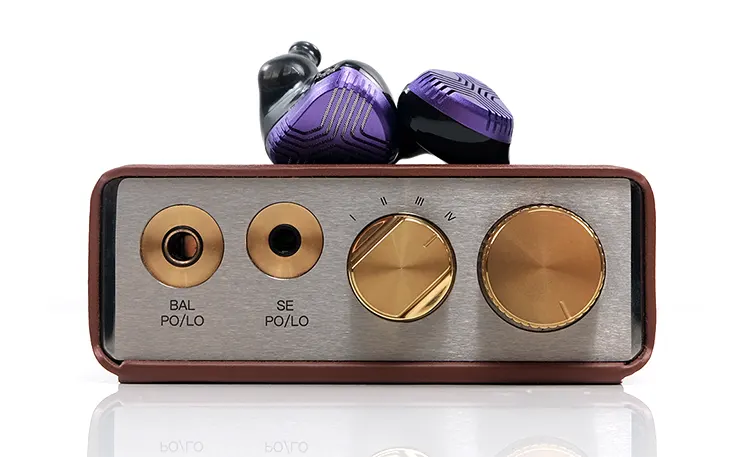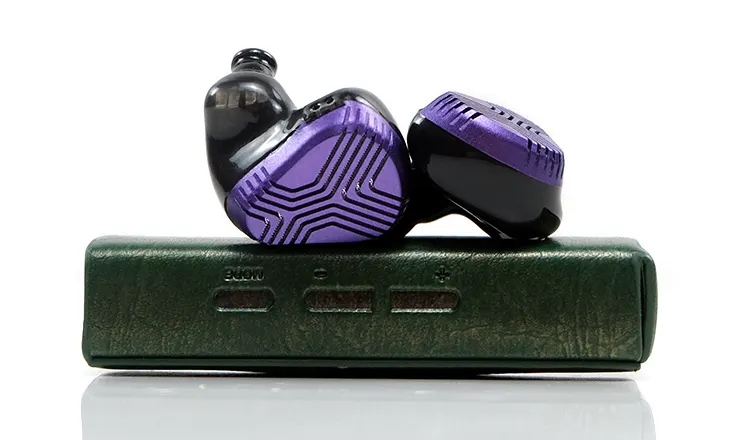Sound Impressions
The following sound impressions of the Vision Ears EXT MKII were completed in balanced mode with the SpinFit tips and stock cable with a mix of the iBasso DX320 MAX Ti, the Cayin RU7, and the Shanling ONIX Mystic XP1.
Summary
The basic premise of the EXT MKII remains largely unchanged from the original. Instead, the team at VE has used this opportunity to tweak certain areas and evolve the sound signature into something arguably more representative of the Vision Ears house sound than its predecessor.
By “more representative,” I mean a better balance between lows and highs, along with a slightly stronger midrange presence to create a more engaging and clearer instrument and vocal performance.
The bass shelf remains incredibly deep and powerful, making it perhaps Vision Ears’ most impactful-sounding in-ear monitor to date, with very satisfying sub-bass reach and presence.
I want to emphasize the sub-bass presence because, unlike the original, the EXT MKII reduces the mid-bass to upper-bass elevation. This creates two noticeable effects.
First, the reduced warmth and bloom results in a more neutral coherent tone in the upper bass and midrange timbre. Second, the emphasis shifts from 50-100Hz down to 20-50Hz, enhancing bass-to-midrange separation and creating a stronger perception of depth and space in the EXT MKII’s soundstage.
Everything above 1k on the EXT MKII seems to have been slightly boosted, including the EST drivers responsible for the highs.
I’d still describe the EXT MKII as having a generally U-shaped sound signature. However, the added vocal presence and improved treble headroom enhance the original’s airiness, resulting in a lighter-bodied tone.
This does influence my preferred pairings somewhat. For vocal-centric tracks, I’d choose a smoother-sounding DAP with a strong vocal presence, such as the Cayin N8ii or the RU7. However, if I want to retain a tight and dynamic low end, I’d go for the HiBy RS8.
Frequency Response
The changes to the EXT MKII’s frequency response from the original can largely be split into two parts: everything below 1k is slightly reduced, while everything above 1k receives a subtle but noticeable lift.
This is perhaps a simplistic way to describe it, given the addictive weight and power that remain. VE has managed to reshape the bass shelf to retain the iconic bass response beloved by original owners while creating a more neutral transition into the mids.
The drop below 1k in the EXT MKII is most noticeable around 50Hz to 200Hz, with an estimated reduction of about 3-4 dB across that range. This reduces the mid-bass emphasis, significantly lessening the original EXT’s bloom.
The result is less warmth but more space and clarity as you transition into the mids. This is where I would switch to a smoother warmer sounding DAP if you want more vocal saturation as the EXT MKII timbre can sound a little leaner compared to the original.
From 1k up to 10k, there’s a subtle lift of about 1-2 dB over the original, with improved pinna gain balanced against the bass from 1-3k, as well as similar upper mids and treble fill from 4-8k. Note that the 4-8k range still attenuates similarly to the original, just less dramatically.
From 8-10k and beyond (within my hearing limits), the EXT MKII has a stronger lift over the original. This adds more sparkle and a cleaner tone with improved headroom and air.
This adjustment shifts the harmonic balance towards a more neutral, clean sound for upper mids timbre compared to the softer original tone, but the enhanced clarity and energy are certainly noticeable.
Staging & Dynamics
The EXT MKII’s staging capability shows a marked improvement over the original. The most notable enhancements are the increased bass-to-mids separation, clearer and more immediate vocal imaging, and improved headroom in the highs.
In short, the soundstage is taller, with pleasing, unaltered depth that creates a grandiose macro-staging quality and an impressive fundamental frequency when needed.
It’s not all “size with no action” above the lows. The EXT MKII’s enhanced mids imaging delivers a better-defined center stage, with vocals more forward and instruments floating around, positioned just slightly behind.
In the original, the midrange imaging felt darker and less revealing, with reduced space due to stronger bass bloom and a softer treble influence.
Synergy
Efficiency & Sensitivity
The Vision Ears EXT MKII is rated with an impedance of 10Ω and an SPL of 108 dB/mW @1kHz. It is unchanged from the original EXT sounding perfectly matched using the same gain stage 5 balanced output volume level from the iBasso DX320 MAX Ti.
They are less efficient than the rest of the VE lineup courtesy of the EST drivers which tend to need more power to operate at optimal levels so the gap in sensitivity between the VE10, Phonix, and the EXT MKII is noticeable.
I also found that enhancing the gain output to the EXT MKII ‘stiffened’ the bass response and vibrancy of the general sound signature. A low gain will work fine though, it’s not hugely inefficient, rather it sounds slightly softer on lower gain levels from the balanced outputs of the RU7 and the DX320 MAX Ti.
DAP Pairings
I tested four DAPs and the ONIX Mystic XP1 portable amplifier using its local TF card playback mode. I had some preferences with clear winners, but these largely depended on what I was listening to.
Right away, I need to eliminate the FiiO M17. It just didn’t pair well with the EXT MKII. The treble sounded slightly off, with some upper mid-harmonics dissonance and a lack of staging depth compared to the other DAP pairings.
The M17/EXT MKII has a good bass performance, and along with the ONIX, these two were probably the most weighted pairings. However, both lacked textured detail to compensate for the weight.
The ONIX also lacks some air and treble extension, producing a darker sound reminiscent of the original EXT sound signature.
The HiBy RS8 was a better pairing. It delivers excellent low-end dynamics with improved layering and texture from the EXT MKII compared to the ONIX and FiiO.
My only reservation was the slightly neutral midrange; it didn’t offer the same presence or smoothness as the Cayin N8ii or the iBasso DX320 MAX Ti.
The N8ii is my pick for maximizing the EXT MKII’s improved midrange tuning. It’s not as spacious as the iBasso but sounds sweeter and less clinical. The bass performance from this pairing trails the other DAP pairings; it has a nice warm, full tone but isn’t as tight or impactful.
The DX320 MAX Ti produced the most dynamic performance from the EXT MKII’s lows, probably the best treble extension, and the deepest soundstage of all the pairings tested.
The vocals are very clean and clear, but my preference was for a slightly richer, more saturated vocal tone, which is why I opted for the N8ii for vocal classics.
Dongle Pairings
I tested four dongles with the EXT MKII. They included the iBasso DC-Elite, Cayin’s RU7 and RU6, and the HiBy FC6.
Out of the four, the RU7 seems tailor-made for the EXT MKII’s sound signature. Paired in balanced mode, the RU7 casts a wide and deep soundstage which really helps with the EXT MKII’s staging strengths.
You also get a nice smooth analog overtone and not too much treble emphasis so the new tuning retains its sparkle and headroom but without thinning out the midrange timbre.
The DC-Elite has better resolution and produces more complex imaging than the RU7. I would also argue it improves the dynamic range from the EXT MKII compared to the RU7 pairing.
My only pullback from recommending the DC-Elite is the excessive treble overtone bleeding into the mids creating some harmonic imbalance. It’s vivid sounding but sometimes too hot to handle.
The FC6 and RU7 have some drawbacks in different areas. The RU6 has some nice lower-midrange bloom and a sweet vocal but lacks the resolution and space of the RU7 which I consider an important asset for this monitor. It also has a softer low-end which isn’t a great outcome for such a dynamic-sounding monitor.
The FC6 suffered from a lack of staging depth through the mids and highs. It will give some joy for bassheads and out of the four it has the thickest vocal tone but its harmonic balance on the EXT MKII pairing was a little rough sounding.




